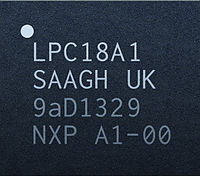The Apple M-series coprocessors are motion coprocessors used by Apple Inc. in their mobile devices. First released in 2013, their function is to collect sensor data from integrated accelerometers, gyroscopes and compasses and offload the collecting and processing of sensor data from the main central processing unit (CPU).
 The NXP LPC18A1, also known as the M7 motion coprocessor | |
| General information | |
|---|---|
| Launched | September 2013 |
| Designed by | M7, M8: NXP Semiconductors |
| Common manufacturer |
|
| Product code | M7: LPC18A1[1] M8: LPC18B1[2] |
| Performance | |
| Max. CPU clock rate | 150[3] MHz |
| Architecture and classification | |
| Technology node | 90 nm[3] |
| Microarchitecture | Cortex-M3[3] |
| Instruction set | ARMv7-M[3] |
| Physical specifications | |
| Cores |
|
The first coprocessor of the series is the M7 (codename Oscar), which was introduced in September 2013 as part of the iPhone 5S.[4][5] Chipworks found that the M7 most likely is a NXP LPC1800 based microcontroller called LPC18A1. It uses an ARM Cortex-M3 core with a customised packaging and naming scheme indicating that it is for an Apple customized part.[1] The updated version M8 was introduced in September 2014 with the iPhone 6 and also processes data from the barometer that is included in the iPhone 6 and iPad Air 2.[6][7] iFixit have identified the M8 in the iPhone 6 to be an NXP device with a very similar name, the LPC18B1.[2][8]
The later coprocessors are embedded into the A-series SoCs. September 2015 brought the M9 motion coprocessor embedded within the A9 chip found in the iPhone 6S, iPhone 6S Plus,[9] first-generation iPhone SE[10] and within the A9X chip found in the first-generation iPad Pro.[11] The iPhone 7, iPhone 7 Plus,[12] second-generation iPad Pro feature the M10 motion coprocessor, embedded within the A10 Fusion and the A10X Fusion chips.[13] Apple included the M11 in the iPhone 8, 8 Plus and iPhone X, embedded within the A11 Bionic SoC.[14]
Starting with the A12 Bionic SoC, Apple has stopped distinguishing the motion coprocessor from the rest of the SoC, and has abandoned the corresponding M-series nomenclature.[15] The M-series nomenclature was reintroduced in 2020 for ARM-based SoCs used in Mac computers and iPad tablets (starting from the 5th generation iPad Pro).
Usage
The Apple M-series coprocessors collect, process, and store sensor data even if the device is asleep, and applications can retrieve data when the device is powered up again. This reduces power draw of the device and saves battery life.[16] In addition to servicing the accelerometer, gyroscope, compass, and in M8 and later coprocessors, barometer, the M9 coprocessor can recognize Siri voice commands from the built in microphones of the device.[17]
The M-series motion coprocessors are accessible to applications through the Core Motion API introduced in iOS 7, so they do, for example, allow fitness apps that track physical activity and access data from the M processors without constantly engaging the main application processor. They enable applications to be aware of what type of movement the user is experiencing, such as driving, walking, running, or sleeping.[18][19][20] Another application could be the ability to do indoor tracking and mapping.[21] In iOS 10, the motion coprocessor is used to implement raise-to-wake functionality, reducing idle energy usage.
Products
| Coprocessor | Processor | Launched | Discontinued | iPhone | iPad | Other | Ref |
|---|---|---|---|---|---|---|---|
| Apple M7 (LPC18A1) |
Apple A7 | September 20, 2013 | March 21, 2017 | iPhone 5S | iPad Air iPad mini 2 iPad mini 3 |
(none) | [4][5] |
| Apple M8 (LPC18B1) |
Apple A8 | September 9, 2014 | May 28, 2019 | iPhone 6 iPhone 6 Plus |
iPad Mini 4 | iPod Touch (6th generation) | [2][8] |
| Apple A8X | October 16, 2014 | March 21, 2017 | (none) | iPad Air 2 | (none) | [7] | |
| Apple M9 | Apple A9 | September 9, 2015 | September 12, 2018 | iPhone 6S iPhone 6S Plus iPhone SE (1st generation) |
iPad (5th generation) | [9][10] | |
| Apple A9X | June 5, 2017 | (none) | iPad Pro (1st generation) | [11] | |||
| Apple M10 | Apple A10 Fusion | September 7, 2016 | May 10, 2022 | iPhone 7 iPhone 7 Plus |
iPad (6th generation) iPad (7th generation) |
iPod Touch (7th generation) | [12][22] |
| Apple A10X Fusion | June 13, 2017 | April 20, 2021 | (none) | iPad Pro (2nd generation) | Apple TV 4K (1st generation) | [13] | |
| Apple M11 | Apple A11 Bionic | September 12, 2017 | April 15, 2020 | iPhone 8 iPhone 8 Plus iPhone X |
(none) | [14] | |
Gallery
- The LPC18A1, also known as the Apple M7. Manufactured week 29 in 2013.
- The size difference between the A7 and the smaller LPC18A1
- The LPC18B1, also known as the Apple M8. Manufactured week 28 in 2014.
- The size difference between the A8 and the smaller LPC18B1
- The size difference between the A8X and the smaller LPC18B1
- The Apple A9 which has the on-die M9 coprocessor
- The Apple A9X which has the on-die M9 coprocessor
- Apple A10 Fusion with on-die M10 coprocessor
- Apple A10X with on-die M10 motion co-processor
- Apple A11 Bionic with on-die M11 motion co-processor
See also
References
Wikiwand in your browser!
Seamless Wikipedia browsing. On steroids.
Every time you click a link to Wikipedia, Wiktionary or Wikiquote in your browser's search results, it will show the modern Wikiwand interface.
Wikiwand extension is a five stars, simple, with minimum permission required to keep your browsing private, safe and transparent.










